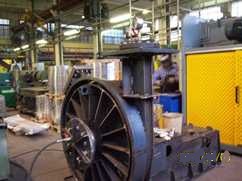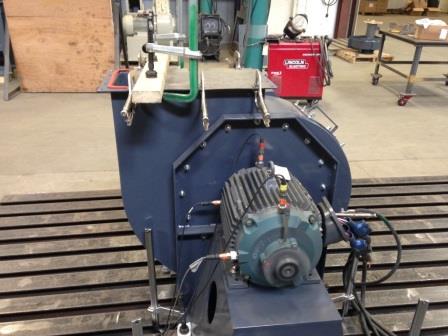Third Party Inspection for Fan and Blower
The Third Party Inspection for Fan and Blower article provides a sample procedure for fan and blower testing and fan and blower inspection in the manufacturing shop. This article needs to be reviewed with fan and blower inspection and test plan.

This content guides you through all the necessary stages in the production of the fans and blowers, including the raw material, final inspection, preservation and packing, and dispatch to site.
You need to take this point into account: this article is written for a typical fan and blower and might not be detailed for special cases.
All fan or blower inspection and testing is done against the approved drawings, purchase order specifications, purchasers or company standards, and within the practices and rules of the country, state or province and any government decrees, laws, ordinance or regulation as may apply.
The fans and blowers which are covered by this guide are four types as below:
- Type A Free Inlet, Free Outlet
- Type B Free Inlet, Ducted Outlet
- Type C Ducted Inlet, Free Outlet
- Type D Ducted Inlet, Ducted Outlet
Fans designed for air circulation are not covered by this content.
The applicable codes and specifications for Fan or Blower which is under construction process are:
- Design code
- Purchase order specification
- Purchaser's standards
- Approved drawings
The applicable codes and standard may be based any international standards. This content is general and can be useful for all applicable standards.
Required Documents for Third Party Inspector Review
The list of documents normally is agreed upon in the Pre-Inspection meeting, which is held several weeks before the actual commencement of the inspection work. The parties that participate in this meeting are the manufacturer, purchaser and third party inspection agency representatives.
These are the list of documents that are normally agreed upon to be presented to the inspector:
- Fan / Blower Purchase Order or Contract
- Fan / Blower Manufacturer Quality Control Manual
- Fan / Blower Manufacturer Quality Control Plan
- Fan / Blower Inspection and test plan
- Fan / Blower Data Sheet
- Fan / Blower Approved Drawings
- Fan / Blower Material Test Reports
- Fan / Blower Fabrication and ducting drawings
- Fan / Blower Welding Specification Procedures (WPS) and Procedure Qualification Records(PQR)
- Fan / Blower Welding Map
- Fan / Blower Welders Qualifications Reports
- Fan / Blower NDE procedures (Radiography, Ultrasonic, Magnetic Particle, Dye Penetration, PMI, etc.)
- Fan / Blower NDE Personnel qualifications Reports
- Fan / Blower Calibration Certificates for Test Equipment
- Fan / Blower Casing/ ducting Pressure Testing Procedure
- Fan / Blower Mechanical Running Test Procedure
- Fan / Blower Performance test procedure
- Fan / Blower Preparation and Painting Procedure
- Fan / Blower Preservation, Packing and Shipping Procedure
- Fan / Blower Packing List
Third Party Inspection for Fan and Blower - Material Inspection
The first actual inspection work in the fan or blower is the materials inspection.The original or authenticated copies of mill certificates of material normally are available at the manufacturer's premises.
The third party inspector examines these certificates for compliance with specifications, and where appropriate, drawings.
The review includes checks on:
- Certificate No.
- Heat or cast No.
- Chemical composition.
- Mechanical properties.
- Heat treated condition.
- NDE applied and results.
- Surface finish
Then the inspector witnesses the materials identification on the certificates against the materials marking. It is also necessary to check these with the fan or blower drawing datasheet, material list and other specifications as appropriate.
Visual inspection for surface finish and probable defects is done and dimensional compliance with specification need to be controlled, as well.
When the third party inspector carries out the material inspection, then provides the inspection visit report (IVR), the report contains the following items:
- Confirmation of satisfactory document review
- Record of the endorsement of certification reviewed/witnessed
- Record of all non-conformities
- Record of any tests witnessed and the result
Third Party Inspection for Fan and Blower - Fabrication Inspection (Welding)
When the fan or blower raw material inspection is carried out, and the results were satisfactory or non-conformities were closed by remedial action, then the fan or blower manufacturer will start fabrication.

The third party inspector checks the following points on the fan or blower, based on the inspection and test plan (ITP), which has already been agreed upon between the purchaser and the fan or blower manufacturer.
The inspection scope is determined in the ITP. Some purchasers prefer to have stringent controls and assign the TPI for more “hold or witness points” for inspection and test activities, and some others prefer less “hold or witness points” and assign the TPI much more work in the “review document.”
This depends in the inspection budget, which purchasers assign for inspection. Much more inspection will have a much larger cost and less risk, and conversely, less inspection will have less cost but more risks.
Following the completion of fabrication and assembly operations the fans / blowers are inspected as required by the specification or contract and purchase order by third party inspector. The inspection consists of:
- Visual inspection for damage
- Dimensional check to drawing requirement
- Inspection of bought out parts
- Review of welder qualifications
- Review of weld procedures
- Confirmation of satisfactory NDE
Third Party Inspection for Fan and Blower – Ducting
Ducting may be of rolled, welded or riveted construction depending on the service requirements. The inspector ensures that the drawing and specification requirements have been met. Particular attention is paid to site connection points.
Third Party Inspection for Fan and Blower Ducting - Pressure Test
When required by the specification ducting may be subjected to low pressure pneumatic test.
Third Party Inspection for Fan and Blower - Construction
The fan and Blower unit is inspected for correct construction, rating, direction of rotation etc. to the drawing and specification requirement.
Evidence of proper impeller dynamic balance and overspeed testing are witnessed when required by the contract or purchase order.
Third Party Inspection for Fan and Blower - Mechanical Run Test
After construction it is usual for the fan and blower unit to be subjected to a mechanical run test using the onsite driver if possible. Particular attention is paid to the following aspects of the test:
- Performance characteristics
- Direction of rotation
- Bearing temperatures
- Vibration
- Noise level
The test would be acceptable if the test result meets the specification.
The fan performance test is performed if required by the specification.
Third Party Inspection for Fan and Blower - Name Plate Control
The third party inspector checks the content in accordance with the approved drawings and specifications and makes sure it is stamped in accordance with the code requirements.
Third Party Inspection for Fan and Blower - Painting and Coating Inspection
Surface preparation for painting is checked for the following points, according to specification by third party inspector:
- Surface preparation type i.e white metal blast cleaning or near-white metal balst cleaning
- Surface profile requirements
- Freedom from weld spatter, blow-holes and other defects
- Dry film thickness is checked according to specification
It is necessary that the surface condition is free from pin-holes, runs damage and other discontinuity.
Third Party Inspection for Fan and Blower - Spares and Accessories:
The third party inspector controls spares, tools and accessories and make visual and dimensional inspection for materials, workmanship and quantity according to purchase order specification and packing list.
Test marks and tags are checked for correct identification.
Third Party Inspection for Fan and Blower - Reporting:
The third party inspector provides an Inspection Visit Report (IVR) after each visit, as well as a final report summarizing the activities carried out during the fan or blower production in accordance with the contract requirements and circulated within the time limits specified in the contract.
The report is in the format required by the client and clearly indicates final acceptance or rejection of the fan or blower.
Third Party Inspection for Fan and Blower - Release Note:
When required by the contract or purchase order, a release note is issued by the third party inspection agency and given to the manufacturer when the fans or blowers have been accepted.
Third Party Inspection for Fan and Blower Packing, Marking and Shipping:
The following points are checked by the third party inspector:
- All exterior machined surfaces are coated with rust preventative
- All internal surfaces which are susceptible to corrosion are coated with rust preventative
- All flanged openings are fitted with metal protectors in accordance with the specification
- All threaded connections are provided with steel plugs
- Ducting is packed in such a manner as to prevent damage or distortion during transportation.
- Manuals and instructions are included as the specification requirements
- Packing style and suitability for overseas shipment meet specification
- Shipping marks control and packing inspection
- Pre-assembled systems are marked as required by the specification
Third Party Inspection for Fan and Blower - Fabrication Shop Documents
The following final documents are reviewed and signed off by the third party inspector in accordance to contract or purchase order requirement.
Manufacturer's data reports, Material certification, Dimensional record, NDE reports, Pressure test reports, Rotor balance report, Mechanical run test report, Final inspection report, Marking inspection report, Packing list, Spare parts list
Free newsletter!
Sign up to receive my monthly newsletter covering all the latest courses and updates.




New! Comments
Have your say about what you just read! Leave me a comment in the box below.